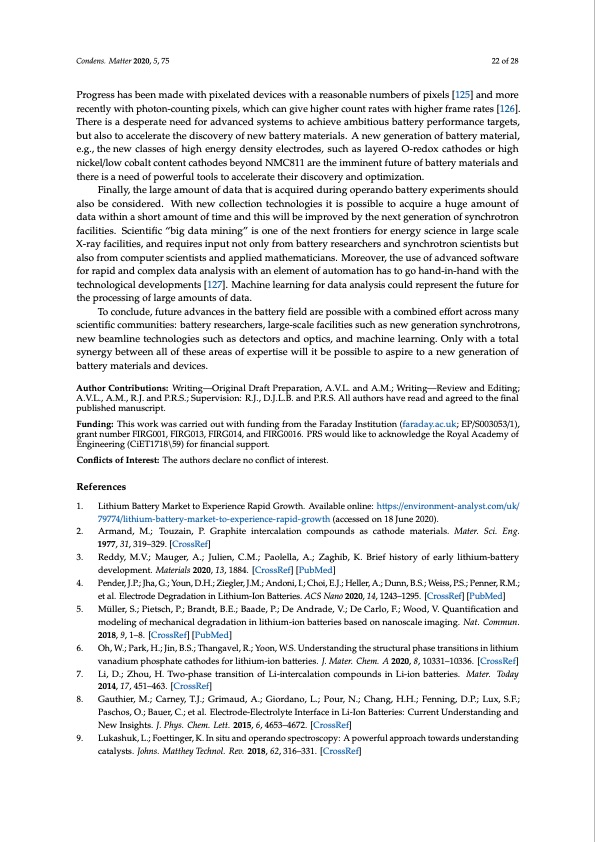
PDF Publication Title:
Text from PDF Page: 022
Condens. Matter 2020, 5, 75 22 of 28 Progress has been made with pixelated devices with a reasonable numbers of pixels [125] and more recently with photon-counting pixels, which can give higher count rates with higher frame rates [126]. There is a desperate need for advanced systems to achieve ambitious battery performance targets, but also to accelerate the discovery of new battery materials. A new generation of battery material, e.g., the new classes of high energy density electrodes, such as layered O-redox cathodes or high nickel/low cobalt content cathodes beyond NMC811 are the imminent future of battery materials and there is a need of powerful tools to accelerate their discovery and optimization. Finally, the large amount of data that is acquired during operando battery experiments should also be considered. With new collection technologies it is possible to acquire a huge amount of data within a short amount of time and this will be improved by the next generation of synchrotron facilities. Scientific “big data mining” is one of the next frontiers for energy science in large scale X-ray facilities, and requires input not only from battery researchers and synchrotron scientists but also from computer scientists and applied mathematicians. Moreover, the use of advanced software for rapid and complex data analysis with an element of automation has to go hand-in-hand with the technological developments [127]. Machine learning for data analysis could represent the future for the processing of large amounts of data. To conclude, future advances in the battery field are possible with a combined effort across many scientific communities: battery researchers, large-scale facilities such as new generation synchrotrons, new beamline technologies such as detectors and optics, and machine learning. Only with a total synergy between all of these areas of expertise will it be possible to aspire to a new generation of battery materials and devices. Author Contributions: Writing—Original Draft Preparation, A.V.L. and A.M.; Writing—Review and Editing; A.V.L., A.M., R.J. and P.R.S.; Supervision: R.J., D.J.L.B. and P.R.S. All authors have read and agreed to the final published manuscript. Funding: This work was carried out with funding from the Faraday Institution (faraday.ac.uk; EP/S003053/1), grant number FIRG001, FIRG013, FIRG014, and FIRG0016. PRS would like to acknowledge the Royal Academy of Engineering (CiET1718\59) for financial support. Conflicts of Interest: The authors declare no conflict of interest. References 1. Lithium Battery Market to Experience Rapid Growth. Available online: https://environment-analyst.com/uk/ 79774/lithium-battery-market-to-experience-rapid-growth (accessed on 18 June 2020). 2. Armand, M.; Touzain, P. Graphite intercalation compounds as cathode materials. Mater. Sci. Eng. 1977, 31, 319–329. [CrossRef] 3. Reddy, M.V.; Mauger, A.; Julien, C.M.; Paolella, A.; Zaghib, K. Brief history of early lithium-battery development. Materials 2020, 13, 1884. [CrossRef] [PubMed] 4. Pender, J.P.; Jha, G.; Youn, D.H.; Ziegler, J.M.; Andoni, I.; Choi, E.J.; Heller, A.; Dunn, B.S.; Weiss, P.S.; Penner, R.M.; et al. Electrode Degradation in Lithium-Ion Batteries. ACS Nano 2020, 14, 1243–1295. [CrossRef] [PubMed] 5. Müller, S.; Pietsch, P.; Brandt, B.E.; Baade, P.; De Andrade, V.; De Carlo, F.; Wood, V. Quantification and modeling of mechanical degradation in lithium-ion batteries based on nanoscale imaging. Nat. Commun. 2018, 9, 1–8. [CrossRef] [PubMed] 6. Oh, W.; Park, H.; Jin, B.S.; Thangavel, R.; Yoon, W.S. Understanding the structural phase transitions in lithium vanadium phosphate cathodes for lithium-ion batteries. J. Mater. Chem. A 2020, 8, 10331–10336. [CrossRef] 7. Li, D.; Zhou, H. Two-phase transition of Li-intercalation compounds in Li-ion batteries. Mater. Today 2014, 17, 451–463. [CrossRef] 8. Gauthier, M.; Carney, T.J.; Grimaud, A.; Giordano, L.; Pour, N.; Chang, H.H.; Fenning, D.P.; Lux, S.F.; Paschos, O.; Bauer, C.; et al. Electrode-Electrolyte Interface in Li-Ion Batteries: Current Understanding and New Insights. J. Phys. Chem. Lett. 2015, 6, 4653–4672. [CrossRef] 9. Lukashuk, L.; Foettinger, K. In situ and operando spectroscopy: A powerful approach towards understanding catalysts. Johns. Matthey Technol. Rev. 2018, 62, 316–331. [CrossRef]PDF Image | Synchrotron-Based X-ray Diffraction for Lithium-Ion Batteries

PDF Search Title:
Synchrotron-Based X-ray Diffraction for Lithium-Ion BatteriesOriginal File Name Searched:
condensedmatter-05-00075.pdfDIY PDF Search: Google It | Yahoo | Bing
Sulfur Deposition on Carbon Nanofibers using Supercritical CO2 Sulfur Deposition on Carbon Nanofibers using Supercritical CO2. Gamma sulfur also known as mother of pearl sulfur and nacreous sulfur... More Info
CO2 Organic Rankine Cycle Experimenter Platform The supercritical CO2 phase change system is both a heat pump and organic rankine cycle which can be used for those purposes and as a supercritical extractor for advanced subcritical and supercritical extraction technology. Uses include producing nanoparticles, precious metal CO2 extraction, lithium battery recycling, and other applications... More Info
| CONTACT TEL: 608-238-6001 Email: greg@infinityturbine.com | RSS | AMP |